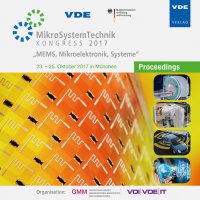Resonance Frequency Tuning and Process Design of a Micromechanical Capacitive Cantilever in a Photoacoustic Trace-Gas Sensing Device
Konferenz: MikroSystemTechnik 2017 - Kongress
23.10.2017 - 25.10.2017 in München, Deutschland
Tagungsband: MikroSystemTechnik 2017
Seiten: 4Sprache: EnglischTyp: PDF
Persönliche VDE-Mitglieder erhalten auf diesen Artikel 10% Rabatt
Autoren:
Zhou, Qi (Ostbayerische Technische Hochschule (OTH) Regensburg, Sensorik ApplikationsZentrum (SappZ), Regensburg, Germany & Technische Universität Hamburg-Harburg, Institut für Mikrosystemtechnik, Hamburg, Germany)
Landgraf, Ferdinand; Rueck, Thomas; Bierl, Rudolf (Ostbayerische Technische Hochschule (OTH) Regensburg, Sensorik ApplikationsZentrum (SappZ), Regensburg, Germany)
Inhalt:
Photoacoustic spectroscopy is an efficient method to detect the concentration of trace gases with following advantages: short response time, high sensitivity, continuous and real-time monitoring and the option of miniaturization without the need of complex mirror-based multi-pass cell designs. A micromechanical cantilever is used as a key component in a two-part “Cantilever-Resonator” system that detects the weak photoacoustic signal. The resonance frequency of cantilever needs to be tuned to match the resonance frequency of resonator in order to achieve the maximum vibration amplitude of the “Cantilever-Resonator” system. This paper reports a post-fabrication method to tune the resonance frequency of cantilevers via focused ion beam (FIB) and a capacitive solution for the cantilever to transform the acoustic signal to electrical signal.


